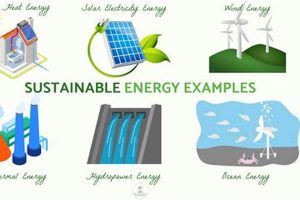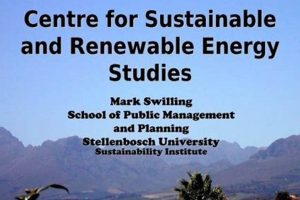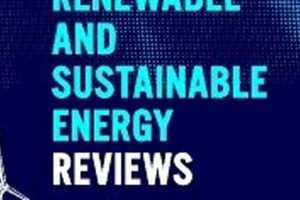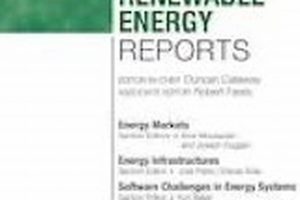Renewable energy refers to energy derived from sources that are naturally replenishing, such as sunlight, wind, rain, tides, and geothermal heat. These resources are virtually inexhaustible on a human timescale. Solar panels converting sunlight into electricity and wind turbines harnessing wind power are prime examples. The defining characteristic is the resource’s ability to regenerate over a relatively short period.
Sustainability, in the context of energy, encompasses a broader concept. It considers the environmental, social, and economic impacts of energy production and consumption. A truly sustainable energy system minimizes pollution, greenhouse gas emissions, and resource depletion, while also promoting social equity and economic viability. Historical reliance on fossil fuels has proven unsustainable due to their finite nature and significant environmental consequences. Achieving energy sustainability necessitates a transition towards cleaner, more responsible energy practices.
While renewable energy sources often contribute to sustainable energy systems, they are not inherently synonymous. A crucial distinction lies in the holistic assessment of long-term impacts. This analysis will explore the nuances of this difference, considering lifecycle assessments, resource dependencies, and the broader implications for a balanced and resilient energy future.
Distinguishing Between Renewable and Sustainable Energy
A clear understanding of the differentiation between renewable and sustainable energy is crucial for informed decision-making in energy policy and investment. Focusing solely on renewability can overlook critical aspects of long-term environmental and societal well-being.
Tip 1: Evaluate the Entire Lifecycle: Assessments should consider the full lifecycle of energy technologies, including manufacturing, operation, and disposal. For example, the mining of materials for solar panels or wind turbines must be factored into their overall environmental impact.
Tip 2: Consider Resource Dependencies: Assess the reliance on finite resources, even within renewable energy systems. Battery storage for solar and wind power requires lithium and other rare earth minerals, the extraction of which can have environmental and social consequences.
Tip 3: Analyze Greenhouse Gas Emissions: While renewable sources generally produce fewer emissions than fossil fuels, some technologies may still contribute to greenhouse gas emissions during their lifecycle. Quantify and compare these emissions across different energy options.
Tip 4: Examine Water Usage: Certain renewable energy technologies, such as some geothermal systems and concentrated solar power, can consume significant amounts of water. Evaluate the impact on local water resources, particularly in arid regions.
Tip 5: Address Land Use Impacts: Large-scale renewable energy projects, such as solar farms and wind farms, require substantial land areas. Consider the impact on biodiversity, agriculture, and community land use.
Tip 6: Promote Energy Efficiency: Reducing energy consumption is a key component of sustainable energy systems. Prioritize energy efficiency measures to minimize the demand for both renewable and non-renewable energy sources.
Tip 7: Foster Innovation and Technological Advancements: Invest in research and development to improve the efficiency, cost-effectiveness, and sustainability of renewable energy technologies.
By thoroughly examining these factors, stakeholders can make more informed decisions that promote energy systems that are both renewable and truly sustainable, minimizing environmental harm and maximizing long-term benefits.
This detailed examination will inform a more comprehensive understanding of the path toward a truly sustainable energy future.
1. Resource Replenishment (Renewable)
The concept of resource replenishment forms the core definition of renewable energy and serves as a fundamental component in differentiating it from sustainable energy. Renewable energy sources are characterized by their natural and continuous replenishment, such as solar, wind, hydro, and geothermal. This inherent ability to regenerate distinguishes them from finite resources like fossil fuels, which are depleted upon extraction and combustion. The rate of replenishment must equal or exceed the rate of consumption for a resource to be considered genuinely renewable.
However, while resource replenishment is a necessary condition for renewable energy, it is not sufficient to guarantee sustainability. For example, a large-scale hydroelectric dam, though utilizing a renewable water source, can have significant environmental and social impacts, including habitat destruction, displacement of communities, and altered river ecosystems. Similarly, biofuel production can deplete arable land and water resources, undermining its long-term sustainability despite relying on renewable biomass. Therefore, simply utilizing a replenishing resource does not automatically qualify as a sustainable practice; broader environmental and social considerations must be integrated.
In summary, resource replenishment is a defining characteristic of renewable energy, ensuring the long-term availability of the energy source. However, sustainability demands a more holistic approach that considers the entire lifecycle and impact of energy production, moving beyond simple resource availability. A focus solely on resource replenishment without addressing broader environmental and social concerns can lead to unsustainable practices under the guise of renewable energy.
2. Lifecycle Impacts (Sustainable)
The assessment of lifecycle impacts constitutes a crucial element in distinguishing sustainable energy from the narrower concept of renewable energy. Sustainable energy systems necessitate a holistic evaluation that extends beyond the immediate energy generation phase to encompass the environmental, social, and economic consequences of the entire value chain.
- Resource Extraction and Manufacturing
Sustainable energy assessments must consider the impacts of resource extraction, processing, and manufacturing of energy technologies. For instance, solar panel production necessitates the mining of raw materials like silicon and rare earth elements. The environmental degradation associated with these mining activities, including habitat destruction and water pollution, must be factored into the overall sustainability analysis. A renewable energy source cannot be deemed truly sustainable if its production relies on environmentally damaging extraction processes.
- Transportation and Infrastructure Development
The transportation of raw materials, components, and finished energy technologies can contribute significantly to carbon emissions and environmental pollution. The construction of energy infrastructure, such as wind farms or hydroelectric dams, also involves habitat disruption and land use changes. Sustainable energy planning requires the minimization of these transportation and infrastructure-related impacts through strategic siting, efficient logistics, and environmentally conscious construction practices. Neglecting these considerations undermines the overall sustainability of a renewable energy project.
- Operational Impacts and Emissions
While renewable energy sources typically produce lower operational emissions compared to fossil fuels, certain technologies may still have environmental consequences during their operational phase. For example, concentrated solar power plants can consume substantial amounts of water for cooling, potentially impacting local water resources. Similarly, hydroelectric dams can alter river ecosystems and contribute to methane emissions from reservoir decomposition. A comprehensive lifecycle assessment evaluates these operational impacts to ensure that the energy system minimizes environmental harm throughout its lifespan. Furthermore, sustainable consideration requires mitigation strategies that reduce the impacts of operational emissions and resource usage.
- Decommissioning and Waste Management
The end-of-life management of energy technologies is a critical aspect of lifecycle impact assessment. Solar panels, wind turbines, and batteries contain materials that require proper recycling or disposal to prevent environmental contamination. The development of effective recycling processes and waste management strategies is essential to minimize the environmental burden associated with the decommissioning of energy systems. Sustainable energy planning incorporates end-of-life considerations from the outset, ensuring that the environmental impacts of decommissioning are minimized and resources are recovered whenever possible.
By comprehensively evaluating lifecycle impacts, decision-makers can differentiate between renewable energy technologies that offer genuine sustainability and those that simply replace one environmental problem with another. A focus on lifecycle assessment is critical for ensuring that energy systems contribute to a more environmentally responsible and economically viable future. This detailed perspective is integral to grasping the difference between merely using renewable resources and constructing genuinely sustainable energy solutions.
3. Environmental Externalities (Sustainable)
Environmental externalities represent a critical dimension in differentiating sustainable energy from renewable energy. These externalities encompass the costs imposed on society and the environment that are not directly reflected in the market price of energy. Failing to account for these externalities can lead to an incomplete and potentially misleading assessment of energy system sustainability.
Within the context of renewable energy, it’s possible to have a source that replenishes itself (e.g., solar, wind) but still generates negative externalities. For example, the manufacturing of solar panels involves extracting raw materials, a process that can lead to habitat destruction, water pollution, and greenhouse gas emissions. Similarly, while wind energy produces minimal emissions during operation, the construction of wind farms can impact bird populations and alter landscapes. A focus solely on renewability without considering these broader environmental consequences fails to capture the full picture. Sustainable energy approaches seek to internalize these externalities, incorporating them into the cost-benefit analysis of energy projects. This can involve implementing stricter environmental regulations, investing in pollution control technologies, or promoting alternative energy sources with lower lifecycle impacts. For instance, a carbon tax on fossil fuels is an attempt to internalize the externality of climate change, making the market price of fossil fuels more accurately reflect their true social cost. Additionally, robust Environmental Impact Assessments (EIAs) are critical tools for identifying and mitigating potential environmental externalities associated with energy projects.
In conclusion, the consideration of environmental externalities is paramount to the concept of sustainable energy. While renewable energy focuses on resource replenishment, sustainable energy aims to minimize the overall environmental burden by accounting for both direct and indirect costs. Ignoring these externalities can lead to unsustainable energy practices, even when relying on renewable resources. A comprehensive and responsible approach to energy production necessitates a rigorous assessment and mitigation of environmental externalities, ensuring a more equitable and environmentally sound energy future. Recognizing and managing these externalities allows for a more informed and responsible transition to a truly sustainable energy landscape.
4. Long-Term Viability (Sustainable)
Long-term viability is a cornerstone of sustainable energy and a critical point of divergence from simply renewable energy. While a resource might be renewable, its utilization is not inherently sustainable if it compromises future generations’ access to resources, environmental quality, or economic stability. The critical distinction rests on the holistic assessment of an energy system’s resilience and enduring benefits, not just its capacity for resource replenishment. This requires considering factors such as the long-term availability of materials needed for energy infrastructure, the adaptability of energy systems to changing climates, and the social acceptance of energy production methods over extended periods. For instance, a large-scale solar farm, while utilizing sunlight, might not be viable long-term if it relies on unsustainable land use practices that degrade soil quality or disrupt local ecosystems, thereby affecting food production and biodiversity.
The absence of long-term viability in energy planning can lead to unforeseen consequences. Consider the historical reliance on certain biofuels. While initially appealing as renewable alternatives to fossil fuels, the extensive land clearing required for their production has resulted in deforestation, soil erosion, and competition with food crops, ultimately undermining their sustainability and economic viability. A more sustainable approach would prioritize biofuels derived from waste products or non-arable land, minimizing negative environmental and social impacts while ensuring a long-term, reliable energy source. Therefore, long-term viability necessitates a comprehensive consideration of not just resource availability but also the broader environmental and social consequences of energy choices over extended time horizons.
In summary, long-term viability distinguishes sustainable energy from merely renewable sources by emphasizing the enduring benefits and resilience of energy systems. Achieving genuine sustainability requires a commitment to responsible resource management, adaptability to future challenges, and social equity, ensuring that energy choices contribute to a stable and prosperous future for all. Ignoring long-term viability in favor of short-term gains from renewable energy can create unintended environmental and social problems, ultimately jeopardizing the goals of energy security and environmental protection. The core point is that sustainability demands an investment in durability and resilience, not just immediate resource replenishment.
5. Socio-Economic Factors (Sustainable)
The integration of socio-economic factors is a defining element differentiating sustainable energy from a purely renewable approach. Sustainable energy strategies necessitate consideration of the impact on communities, economies, and social equity, extending beyond mere resource replenishment or environmental impact reduction. Ignoring these factors can lead to energy projects that, while technically renewable, are socially disruptive or economically unviable, ultimately undermining their long-term sustainability. For example, a large-scale biofuel project that displaces local farmers or drives up food prices, despite utilizing a renewable resource, would not qualify as sustainable. Similarly, renewable energy projects reliant on imported components or technologies may create economic dependence, hindering local economic development and reducing overall energy security.
A sustainable energy transition should foster job creation, promote local industries, and improve access to affordable and reliable energy for all segments of society. This includes addressing energy poverty, ensuring equitable access to renewable energy technologies, and empowering communities to participate in energy planning and decision-making. Community-owned renewable energy projects, for instance, can generate local income, reduce reliance on external energy sources, and foster a sense of ownership and responsibility for energy resources. Moreover, investments in education and training related to renewable energy technologies can create new job opportunities and promote a skilled workforce, contributing to long-term economic growth and social development. For example, the development of a wind turbine manufacturing plant in a rural community not only provides clean energy but also creates local employment and strengthens the regional economy.
In conclusion, the inclusion of socio-economic factors is crucial for ensuring that energy systems are not only environmentally sound but also socially just and economically beneficial. Sustainable energy planning requires a holistic approach that considers the needs and priorities of communities, promotes local economic development, and fosters social equity. By integrating socio-economic considerations into energy strategies, policy-makers can create more resilient, equitable, and sustainable energy systems that contribute to a brighter future for all. Failing to account for these factors risks creating energy systems that exacerbate existing social and economic inequalities, ultimately hindering the transition to a truly sustainable energy landscape. The practical significance of this understanding is manifest in creating lasting, positive impacts on society while promoting environmental stewardship.
6. Resource Depletion (Renewable vs. Sustainable)
The critical distinction between renewable and sustainable energy becomes particularly evident when examining the issue of resource depletion. While renewable energy sources are characterized by their ability to regenerate naturally, the infrastructure and technologies required to harness them often depend on finite resources, potentially leading to resource depletion. This dependence highlights a key point: renewable does not automatically equate to sustainable. A wind turbine, for instance, utilizes a renewable energy source (wind), but its construction relies on steel, concrete, and rare earth elements, all of which are extracted from the earth. Similarly, solar panels require silicon and other specialized materials whose extraction and processing can have significant environmental consequences. If the rate of extraction of these materials exceeds their rate of natural replenishment or recycling, it leads to depletion, undermining the long-term viability of the renewable energy system. A truly sustainable energy system minimizes reliance on non-renewable resources throughout its lifecycle, from manufacturing to disposal.
Furthermore, even the renewable resources themselves can be subject to depletion if managed unsustainably. Over-extraction of geothermal energy, for instance, can lead to a decline in reservoir temperatures, reducing the energy output and potentially damaging the resource. Similarly, excessive reliance on biomass for energy can result in deforestation and soil degradation, diminishing the long-term availability of this renewable resource. The interplay between the use of renewable resources and the avoidance of depleting non-renewable resources crucial for infrastructure is a key factor in establishing a genuinely sustainable energy system. The sustainable approach calls for the strategic diversification of energy sources, investment in recycling technologies, and the development of more resource-efficient energy infrastructure.
In summary, the issue of resource depletion underscores the fundamental difference between renewable and sustainable energy. While renewable energy focuses on using naturally replenishing resources, sustainable energy emphasizes minimizing the overall environmental and social impact of energy production and consumption, including the depletion of both renewable and non-renewable resources. A sustainable energy system strives for resource efficiency, circularity, and long-term viability, ensuring that energy production does not compromise the ability of future generations to meet their own needs. This understanding is of practical significance in informing energy policy, guiding investment decisions, and promoting innovation in energy technologies, ultimately contributing to a more environmentally responsible and economically sound energy future.
Frequently Asked Questions
This section addresses common inquiries regarding the distinctions between renewable and sustainable energy, providing clarity on their respective definitions and implications.
Question 1: Is all renewable energy inherently sustainable?
No. While renewable energy sources replenish naturally, their utilization can still involve unsustainable practices, such as environmentally damaging extraction of materials for infrastructure or habitat destruction during construction. Sustainability requires a holistic assessment of lifecycle impacts.
Question 2: What are the primary factors that differentiate sustainable energy from renewable energy?
Sustainable energy encompasses a broader scope than renewable energy. It considers lifecycle impacts, environmental externalities, long-term viability, socio-economic factors, and resource depletion, ensuring that energy systems are not only renewable but also environmentally responsible, economically viable, and socially equitable.
Question 3: How does lifecycle assessment contribute to the understanding of sustainable energy?
Lifecycle assessment provides a comprehensive evaluation of the environmental impacts associated with an energy system throughout its entire life cycle, from resource extraction to decommissioning. This assessment helps identify potential sustainability challenges and informs strategies for minimizing environmental harm.
Question 4: Why are environmental externalities important when evaluating energy sustainability?
Environmental externalities, such as pollution and climate change, represent costs imposed on society and the environment that are not reflected in market prices. Sustainable energy strategies aim to internalize these externalities, ensuring that the true costs of energy production are accounted for.
Question 5: What role do socio-economic factors play in sustainable energy development?
Socio-economic factors are crucial for ensuring that energy systems are equitable and beneficial to communities. Sustainable energy strategies should promote job creation, support local economies, improve access to affordable energy, and empower communities to participate in energy planning.
Question 6: How does resource depletion relate to the concept of sustainable energy?
Sustainable energy seeks to minimize resource depletion, both of renewable and non-renewable resources. It promotes resource efficiency, recycling, and the development of energy infrastructure that relies on abundant and sustainably managed resources.
In summary, while renewable energy focuses on the source of energy, sustainable energy prioritizes the holistic impact and long-term viability of energy systems, encompassing environmental, social, and economic dimensions.
The following section will address policy and implementation strategies.
Conclusion
This examination has clarified that renewable energy and sustainable energy, while related, are distinct concepts. The former refers to energy derived from naturally replenishing sources, while the latter encompasses a more comprehensive approach that considers environmental, social, and economic impacts throughout the energy system’s lifecycle. The critical distinction lies in the holistic assessment, ensuring long-term viability and minimal negative externalities.
The global transition towards a more responsible energy future demands a shift from simply adopting renewable sources to implementing truly sustainable practices. This requires rigorous lifecycle assessments, consideration of socio-economic factors, and a commitment to minimizing resource depletion. Policy decisions and technological innovations must prioritize solutions that are not only renewable but also resilient, equitable, and environmentally sound, ensuring a lasting legacy of responsible energy stewardship.







